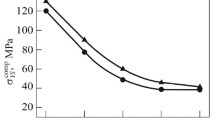Abstract
All industrial alloys of the Al−Mg system correspond to the region of the α-solid solution of the phase diagram. Domestic alloys AL8 and AL27-1 and foreign alloys 520 (USA) and LM-10 (Great Britain) with a high magnesium content (9–11%) have high mechanical properties after quenching. However, they possess a high sensitivity to natural aging under conditions of long-term operation or storing, which causes their embrittlement. The aim of the present work consists in developing an Al−Mg-base composition quenched and aged artificially that will possesses a high strength (σ t =380-400 N/mm2) and will not change in operation at a temperature of at most 100°C.
Similar content being viewed by others
Author information
Authors and Affiliations
Additional information
Translated from Metallovedenie i Termicheskaya Obrabotka Metallov, No. 6, pp. 13–16, June, 1997.
Rights and permissions
About this article
Cite this article
Goncharenko, E.S., Mel'nikov, A.V., Cherkasov, V.V. et al. Effect of quenching regimes on the structure and properties of an alloy from the Al−Mg system. Met Sci Heat Treat 39, 244–246 (1997). https://doi.org/10.1007/BF02467228
Issue Date:
DOI: https://doi.org/10.1007/BF02467228




